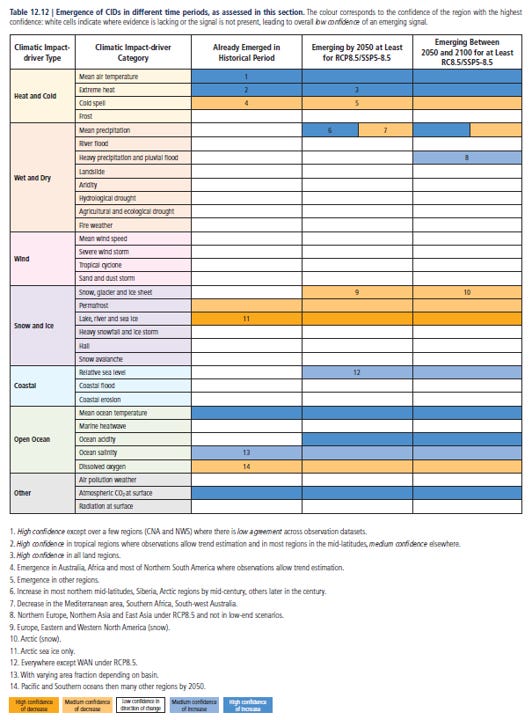IPCC and Extreme Weather
Let’s take a look what IPCC AR6 says about the time of emergence for various extreme events.

Back to extreme weather — let’s take a look what IPCC AR6 says about the time of emergence for various extreme events. Here are some direct quotes related to specific phenomena:
- An increase in heat extremes has emerged or will emerge in the coming three decades in most land regions (high confidence)
- There is low confidence in the emergence of heavy precipitation and pluvial and river flood frequency in observations, despite trends that have been found in a few regions
- There is low confidence in the emergence of drought frequency in observations, for any type of drought, in all regions.
- Observed mean surface wind speed trends are present in many areas, but the emergence of these trends from the interannual natural variability and their attribution to human-induced climate change remains of low confidence due to various factors such as changes in the type and exposure of recording instruments, and their relation to climate change is not established. . . The same limitation also holds for wind extremes (severe storms, tropical cyclones, sand and dust storms).
The IPCC helpfully provides a summary table for a range of extremes, indicating for various phenomena whether emergence has been achieved with medium or high confidence at three points in time:
- to date (today), i.e., specifically when IPCC AR6 was completed in 2021,
- by 2050 under RCP8.5/SSP5-8.5, and
- by 2100 under RCP8.5/SSP5-8.5.
Those three dates are displayed as the 3 right-most column in the table below.
A white entry in the table means that emergence has not yet been or is not in the future expected to be achieved. The blue and orange entries represent the emergence of respectively increasing and decreasing signals at various levels of confidence.
Take a moment and look at the table carefully. Look especially at all those white cells.

The IPCC has concluded that a signal of climate change has not yet emerged beyond natural variability for the following phenomena:
- River floods
- Heavy precipitation and pluvial floods
- Landslides
- Drought (all types)
- Severe wind storms
- Tropical cyclones
- Sand and dust storms
- Heavy snowfall and ice storms
- Hail
- Snow avalanche
- Coastal flooding
- Marine heat waves
Furthermore, the emergence of a climate change signal is not expected under the extreme RCP8.5 scenario by 2100 for any of these phenomena, except heavy precipitation and pluvial floods and that with only medium confidence. Since we know that RCP8.5 is extreme and implausible, that means that there would even less confidence in emergence under a more plausible upper bound, like RCP4.5
